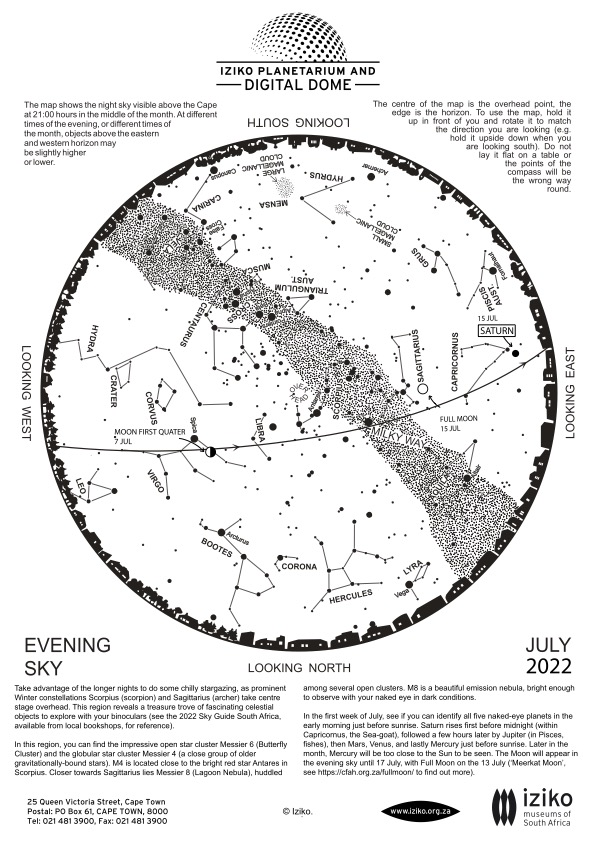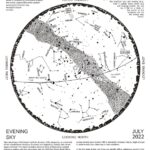
02 Jul Whats Up – July 2022
In a nutshell…
Moon
| Date | Time | Phase |
|---|---|---|
| 07/07 | 04h14 | First Quarter |
| 13/07 | 20h37 | Full Moon |
| 20/07 | 16h18 | Last Quarter |
| 28/07 | 19h654 | New Moon |
Moon – Earth Relations
Perigee: 357 264 km on the 13/07 at 11h05
Apogee: 406 274 km on the 26/07 at 12h21
Planet Visibility
Mercury is visible in the morning sky near the stars of the constellation Taurus at the beginning of the month; reaches superior conjunction on the 16th of July and is visible in the evening sky thereafter
Venus is visible in the morning sky near the stars of the constellation Taurus
Mars is visible in the morning sky near the stars of the constellation Pisces
Jupiter is visible in the morning sky near the stars of the constellation Pisces
Saturn is visible in the morning sky and is located near Capricornus
Meteor Showers
Four meteor showers are active in July. The July Phoenicids meteor shower is active from the 10th of July to the 16th of July, peaking on the 13th. To view the shower, find a dark spot and look near the constellation of Phoenix. The best time to view the July Phoenicids is from 23:00 low in the SE to 05:00, when they’ll be nearly overhead towards the SE.
The Southern delta Aquariids meteor shower is active from the 21st of July to the 29th of August, peaking on the 30th of July. To view the Southern delta Aquariids, find a dark spot and look near the constellation of Aquarius for the Southern delta Aquariids radiant. The best time to view the Southern delta Aquariids is from around 22:00 in the east until dawn, when they’ll be in the NW.
The alpha Capricornids meteor shower is active from the 15th of July to the 25th of August, peaking on the 30th of July. To view the shower, look near the constellation of Capricornus for the alpha Capricornids radiant. The best time to view the alpha Capricornids is from around 20:00 in the east until 04:00, when they’ll be in the west.
The Piscis Austrinids are active from the 19th of July to the 17th of August, peaking on the 29th of July. They are best viewed between 21:30 (east) and 05:00 (west) looking towards the constellation of Piscis Austrinus (the Southern Fish, not to be confused with Pisces).
Some easy to identify bright stars
Rigel: blue supergiant in Orion
Betelgeuse: red supergiant in Orion
Procyon: yellowish white star in Canis Minor
Sirius: brightest star in the night sky, located in Canis Major
Antares: red supergiant in Scorpius
Arcturus: red giant in Boötes
Spica: brightest bluish-white star in Virgo
Canopus: yellowish-white star in Carina
Altair: a white star, brightest in Aquila
Regulus: blue–white star and the brightest star in Leo
The Pointers: Alpha and Beta Centauri
Sun and Moon
The First Quarter Moon falls on the 7th of July at 04h14 and the Full Moon occurs on the 13th of July at 20h37. The Last Quarter Moon falls on the 20th of July at 16h18 and the New Moon occurs on the 28th of July at 19h54.
The Moon will be at perigee (closest approach to Earth) at a distance of about 357 264 km on the 13th of July at 11h05. We will therefore have a Supermoon on the 13th of July, don’t miss out! On the 26th of July at 12h21, the Moon will be at apogee (furthest from Earth) at a distance of about 406 274km.
Planetary and Other Events – Morning and Evening
Mercury, Venus, Mars, Jupiter and Saturn are still visible in the morning sky. Even though one has to wake up early, this is a great opportunity to see the planets; share the excitement and beauty of the sky with family and others. Mercury can be observed near the stars of the constellation Taurus. It reaches superior conjunction on the 16th of July and enters the evening sky. Mercury will be near the Moon on the 30th of July. Venus can also be located near the stars of the constellation Taurus. Venus will be near the Moon on the 26th of July. Mars and Jupiter can be located near the stars of the constellation Pisces. The Moon will be near Jupiter on the 19th of July. Saturn can be located the near the stars of the constellation Capricornus. The Moon will be near Saturn on the 15th of July.
The dwarf planet Pluto reaches opposition on 20 July and is therefore well positioned for observation, albeit with a large telescope only. It can be located near the stars of the constellation Sagittarius.
Four meteor showers are active in July. The July Phoenicids meteor shower is active from the 10th of July to the 16th of July, peaking on the 13th. To view the shower, find a dark spot and look near the constellation of Phoenix. The best time to view the July Phoenicids is from 23:00 low in the SE to 05:00, when they’ll be nearly overhead towards the SE.
The Southern delta Aquariids meteor shower is active from the 21st of July to the 29th of August, peaking on the 30th of July. To view the Southern delta Aquariids, find a dark spot and look near the constellation of Aquarius for the Southern delta Aquariids radiant. The best time to view the Southern delta Aquariids is from around 22:00 in the east until dawn, when they’ll be in the NW.
The alpha Capricornids meteor shower is active from the 15th of July to the 25th of August, peaking on the 30th of July. To view the shower, look near the constellation of Capricornus for the alpha Capricornids radiant. The best time to view the alpha Capricornids is from around 20:00 in the east until 04:00, when they’ll be in the west.
The Piscis Austrinids are active from the 19th of July to the 17th of August, peaking on the 29th of July. They are best viewed between 21:30 (east) and 05:00 (west) looking towards the constellation of Piscis Austrinus (the Southern Fish, not to be confused with Pisces).
The Evening Sky Stars
The Milky Way is a dominant presence on July evenings, with the brilliant stars of Centaurus nearly overhead, and the Cross just to the south. Marking the southern edge of the Milky Way below the Centaur are the dimmer stars of the Housefly and the Southern Triangle. To the west of Centaurus along the Milky Way is the great ship Argo, with Canopus, second brightest star in the night sky, glowing low in the SW. Sirius appears brighter in our sky because it’s so much closer (9 light years, compared to Canopus’ distance of 313 light years), but Canopus is a supergiant star, 8-9 times as massive as our own Sun, 65 times the Sun’s diameter and 15,000 times as bright. Although the surface temperature of Canopus is ‘only’ 7800 degrees, its atmosphere is heated to about 20 million degrees, meaning plenty of hard radiation for any alien astronaut unfortunate enough to be nearby.
To the east of the Centaur are the stars of the Wolf and the Scorpion, with the Altar just to the south at the edge of the Milky Way. But the thickest part of the Milky Way lies around Sagittarius, the Archer, and the stars of the Scorpion’s sting. In this direction is the centre of our galaxy, and hidden by thick dust clouds is the black hole in the exact centre, 4 million times the mass of our Sun and a bit smaller than the size of Mercury’s orbit. Radio waves can penetrate the dust, though, and the Event Horizon Telescope, a worldwide network of radio telescopes, managed to capture an image of the black hole.
Just north of the Centaur is the tail of Hydra, the giant water snake, with its body extending far into the west almost parallel to the Milky Way. Low in the west is Alphard (Arabic for ‘the solitary one’). Low in the NW are the stars of the Lion, while low in the NE are the dim stars of the great hero Hercules with the delicate semi-circle of the Northern Crown between it and a bright orange Arcturus (Latinized from Greek for ‘the Guard’) low in the north.
Arcturus is the brightest star in Boötes (the Herdsman), which some say is the most ancient constellation in the sky. It looks brighter than any other star in the northern hemisphere night sky, and is an orange giant 37 light years away, 215 times as bright as our Sun, and 26 times the Sun’s diameter. Arcturus’ orbit around the centre of the galaxy is quite different from the orbits followed by most stars in our neighbourhood, and it has only 20% as much iron. One possible explanation is that it may originally have been part of a small galaxy that merged with our Milky Way billions of years ago.
The Morning Sky Stars
The Milky Way runs completely around the horizon on July mornings, appearing low in the sky in every direction. That means that when you look overhead you are looking straight from our Milky Way galaxy toward the South Galactic Pole.
Orion the Hunter, with orange Betelgeuse and blue-white Rigel, is rising in the east. From the northeast, the V-shape of the Bull’s head (with bright Aldebaran as the Bull’s glowing eye) charges Orion. And riding on the back of the Bull is the open cluster of stars called the Pleiades, which is about 400 light-years away. The Pleiades are also widely known as the Seven Sisters, and known to the Namaquas as “the daughters of the sky god”.
Low in the ESE we see brilliant Sirius, brightest star in the night sky, among the other stars of Orion’s Large Dog, while the Hare scampers between the Dog and the Hunter. Canopus, second-brightest star in the night skiy, seen in the southeast on July mornings, is marking the Keel of the upside-down Ship Argo. (As most of the constellations were invented in the northern hemisphere, we tend to see them bottom side up.) High in the south is bright Achernar (Arabic for ‘the End of the River’), marking one end of the celestial river Eridanus. The other end is near Rigel about where Orion’s knee would be. Below Achernar in the south are the southern Water Snake and the Toucan, with the Peacock a bit lower in the SW. Its brightest star Alpha Pavonis is actually a pair of hot, luminous blue-white stars about 179 light years away, revolving around each other every 11.75 days. It’s about 2200 times as luminous as the Sun.
High in the W are the Crane and the Southern Fish with its bright star Fomalhaut (Arabic for ‘the mouth of the Fish’), with the stars of the Sea Goat making a dim irregular triangle a bit lower in the W. High in the N and NE is the appropriately large constellation of the Whale, reminding us that in a couple of months it will be time for whale-watching again along the Cape coast.
Sivuyile Manxoyi
sivuyile@saao.ac.za
Twitter: @rassivuyile
The evening sky over Cape Town
The evening sky over Johannesburg

